Gameplay Performance – Ray Tracing
In the gaming performance below, we are comparing performance at 1080p with Ray Tracing enabled to represent a more reasonable and attainable gameplay experience goal with these graphics cards. At 1080p, we can see, without bottlenecks, how performance compares and the kind of gameplay experience one can achieve with higher playable framerates. With Ray Tracing, we sometimes will be using lower Ray Tracing quality settings for these comparisons today, due to the performance tier of the GPUs.
For the video card comparisons, we are including an NVIDIA GeForce RTX 4060 Ti 8GB FE model, this is the 8GB model, not 16GB. We are also including a GeForce RTX 4070 12GB FE video card, for comparison’s sake. On the AMD side, we are including a factory-overclocked XFX Speedster QICK 319 Radeon RX 7700 XT Black Edition 12GB, and a factory-overclocked SAPPHIRE PULSE Radeon RX 7600 XT 16GB video card.
Alan Wake 2
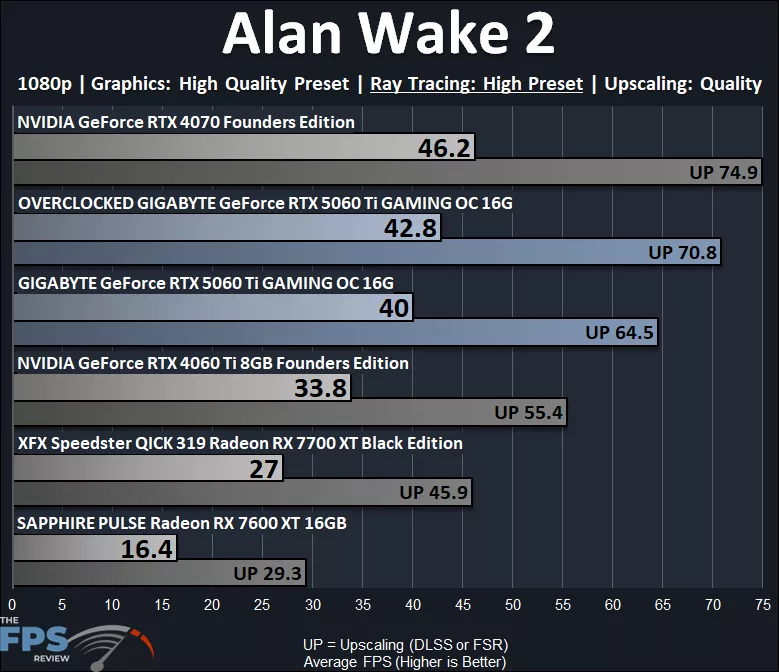
In Alan Wake 2, we are running at 1080p with the “High” quality Ray Tracing preset enabled, not the new Ultra quality; this is one setting down from Ultra. This was required because the new Ultra RT mode is not available on AMD Radeon GPUs; to make a comparison, we must use the High RT preset.
Enabling Ray Tracing is quite demanding, even at 1080p. The GIGABYTE GeForce RTX 5060 Ti GAMING OC 16G does not offer a playable experience at “High” RT at 1080p without the aid of DLSS Upscaling. With DLSS Upscaling, the game is playable at 60FPS, but without it is not, but this is also true of the GeForce RTX 4070. The GIGABYTE GeForce RTX 5060 Ti GAMING OC 16G is 18% faster than the previous generation GeForce RTX 4060 Ti 8GB FE video card, offering an ok level of performance increase, but not great at these lower framerates.
The GeForce RTX 4070 is faster, and the GIGABYTE GeForce RTX 5060 Ti GAMING OC 16G is 13% slower than the GeForce RTX 4070. When overclocked, the GIGABYTE GeForce RTX 5060 Ti GAMING OC 16G gains only 7% performance, but that doesn’t give you much in terms of framerate at these low framerates, though it does help more with DLSS Upscaling performance at 70FPS, which is very smooth.
Black Myth: Wukong
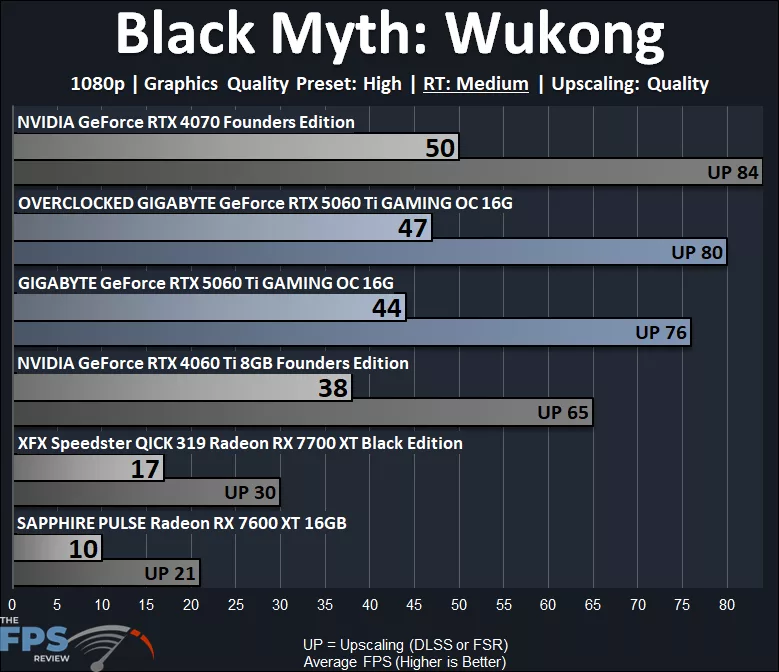
In Black Myth: Wukong, we absolutely had to drop the Ray Tracing quality down to just the “Medium” quality preset, as well as the Graphics Quality itself at just “High”. Therefore, the main graphic quality is at “High” and RT is at “Medium”. Even at this lowered RT setting, the game is not playable without DLSS Upscaling at 1080p, offering only 44FPS. However, with DLSS Upscaling, performance is at 76FPS, and the game is playable in terms of performance, and this is better than the RTX 4060 Ti 8GB FE.
The GIGABYTE GeForce RTX 5060 Ti GAMING OC 16G is 16% faster than the GeForce RTX 4060 Ti 8GB FE, but the real benefit is with DLSS Upscaling performance. The GeForce RTX 4070 FE is faster, the GIGABYTE GeForce RTX 5060 Ti GAMING OC 16G is 12% slower than the GeForce RTX 4070. Overclocking improves performance by 7%, but the RTX 4070 is still faster.
Cyberpunk 2077
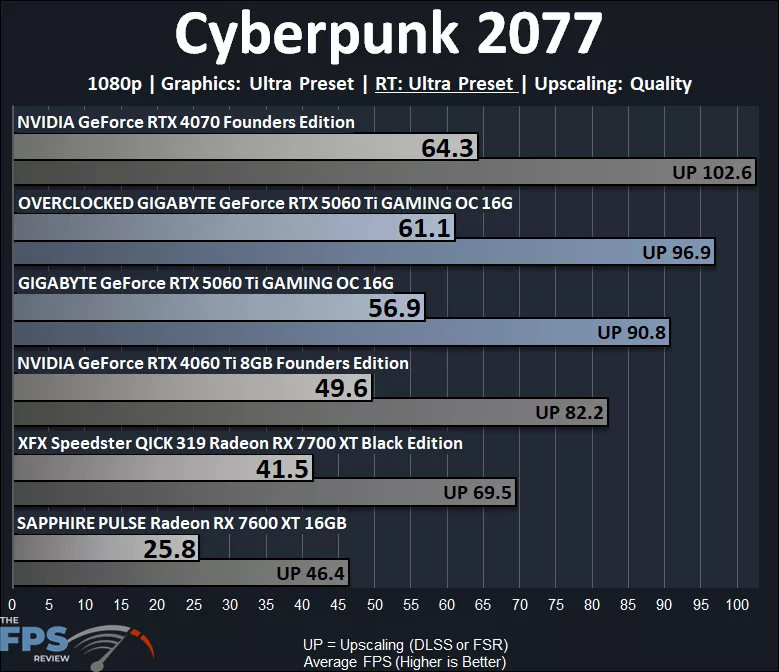
In Cyberpunk 2077, we are running at 1080p and the “Ultra” RT preset here, which actually worked out. The GIGABYTE GeForce RTX 5060 Ti GAMING OC 16G is riding the border on what’s playable, but with DLSS Upscaling, it is most certainly playable at 90FPS. The GIGABYTE GeForce RTX 5060 Ti GAMING OC 16G is 15% faster than the GeForce RTX 4060 Ti 8GB FE. The GeForce RTX 4070 FE is faster, the GIGABYTE GeForce RTX 5060 Ti GAMING OC 16G is 12% slower than the GeForce RTX 4070. Overclocking improves performance by 7%, but the RTX 4070 is still faster.
Indiana Jones and the Great Circle
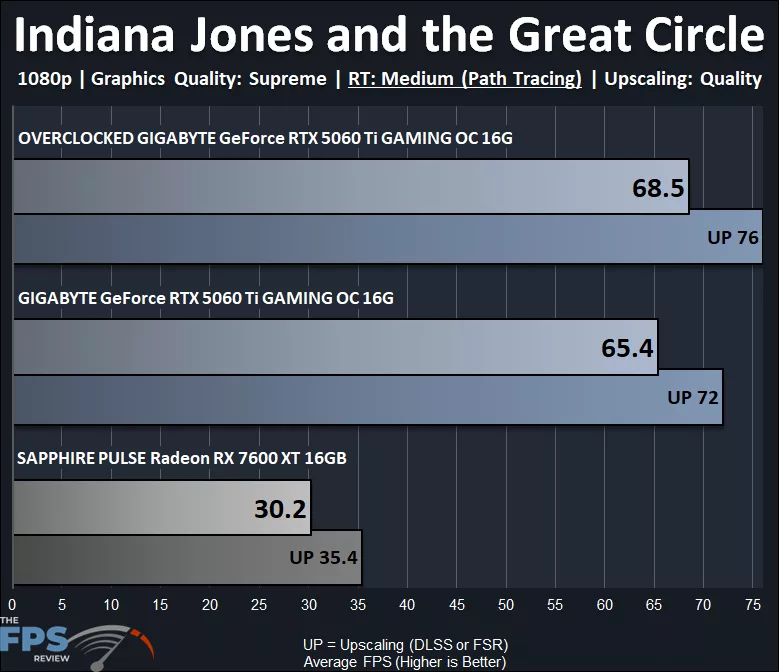
In order to run the path tracing mode in Indiana Jones and the Great Circle, only the 16GB VRAM graphics cards would work; anything less, even the 12GB models, would crash with out-of-VRAM error messages at 1080p. Therefore, the only two cards we could even compare are the Radeon RX 7600 XT 16GB and the GIGABYTE GeForce RTX 5060 Ti GAMING OC 16G. We are using the ‘lowest’ RT setting in this game, which is “Medium” RT (Path Tracing) setting, and the “Supreme” main graphics settings.
It’s no shocker that the GIGABYTE GeForce RTX 5060 Ti GAMING OC 16G is a lot faster than the Radeon RX 7600 XT here, 117% faster. The important takeaway from this game is that the GIGABYTE GeForce RTX 5060 Ti GAMING OC 16G is delvering a playble gameplay experience at 1080p on “Supreme” with “Medium” Path Tracing at 65FPS, and with DLSS Upscaling at 72FPS, so the game is very playable on the GIGABYTE GeForce RTX 5060 Ti GAMING OC 16G. This is mostly thanks to the 16GB of VRAM; without that capacity, it wouldn’t be possible in this game.
Star Wars Outlaws
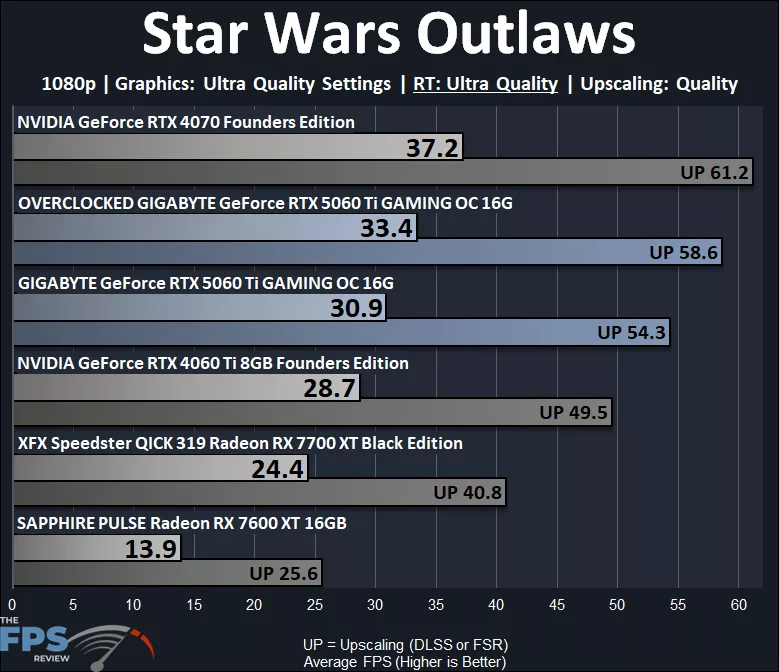
In Star Wars Outlaws, we are running at 1080p and the RT Ultra Quality mode here. This game is completely not playable on Ultra RT, even with DLSS Upscaling, it’s borderline at 54FPS on the game. In practice, we’d recommend turning down the RT option much lower, or even off, for the best performance. The GIGABYTE GeForce RTX 5060 Ti GAMING OC 16G is only 8% faster than the GeForce RTX 4060 Ti 8GB FE, so in this game, that’s the lowest uplift we’ve seen yet; it’s very bottlenecked by the highest RT option. The GIGABYTE GeForce RTX 5060 Ti GAMING OC 16G is 17% slower than the GeForce RTX 4070, which does RT much faster.
